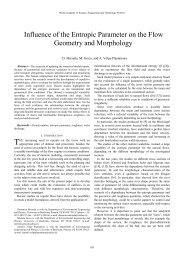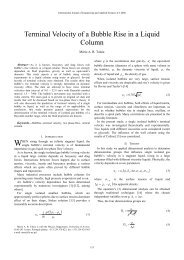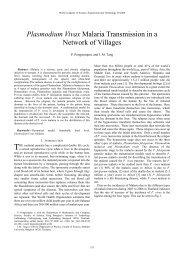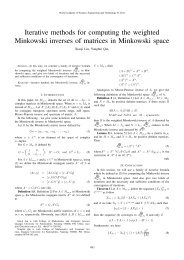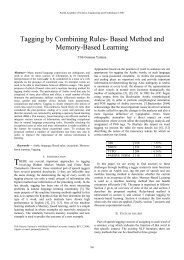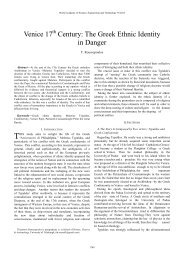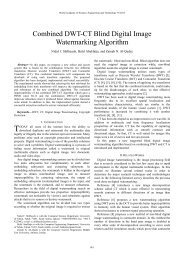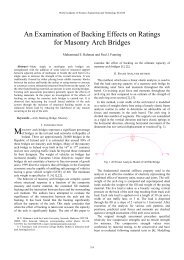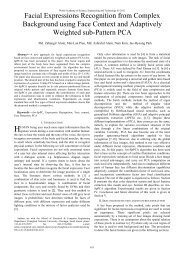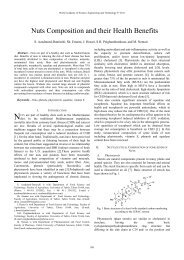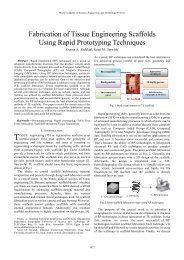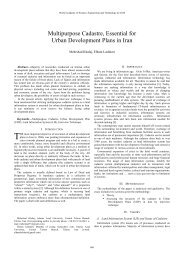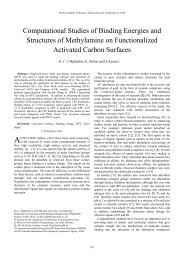Survival of Listeria monocytogenes Inoculated in Retail Yogurt ...
Survival of Listeria monocytogenes Inoculated in Retail Yogurt ...
Survival of Listeria monocytogenes Inoculated in Retail Yogurt ...
Create successful ePaper yourself
Turn your PDF publications into a flip-book with our unique Google optimized e-Paper software.
World Academy <strong>of</strong> Science, Eng<strong>in</strong>eer<strong>in</strong>g and Technology 41 2010<strong>Survival</strong> <strong>of</strong> <strong>Listeria</strong> <strong>monocytogenes</strong> <strong>Inoculated</strong><strong>in</strong> <strong>Retail</strong> <strong>Yogurt</strong> ProductsYu-Hsien Hsieh, Jiang-Gong Liu, and J.C. HwangAbstract—Commercial products classified as low-fat yogurt (Y1),full-fat yogurt (Y2), AB-yogurt (Y3), and lact<strong>of</strong>err<strong>in</strong>-fortified yogurt(Y4) us<strong>in</strong>g four <strong>Listeria</strong> <strong>monocytogenes</strong> as a cocktail <strong>in</strong>oculum. Thesamples were stored at 4–7℃ and 22℃. The ability <strong>of</strong> L.<strong>monocytogenes</strong> to survive at different storage temperatures has beenwidely explored s<strong>in</strong>ce the temperature-related abuse <strong>of</strong> food products<strong>of</strong>ten occur food products are commonly not ma<strong>in</strong>ta<strong>in</strong>ed at theappropriate temperature. Our results <strong>in</strong>dicate that all four retail yogurtproducts studied here<strong>in</strong> supported the growth <strong>of</strong> L. <strong>monocytogenes</strong> atrefrigeration temperatures (4–7℃). AB-yogurt andlact<strong>of</strong>err<strong>in</strong>-fortified yogurt, however, significantly <strong>in</strong>hibited thegrowth <strong>of</strong> L. <strong>monocytogenes</strong> <strong>in</strong> this temperature range. Changes <strong>in</strong> thepH, Brix, Baume, and total soluble solids (TSS) <strong>of</strong> retail yogurt andmilk products caused by changes <strong>in</strong> the number <strong>of</strong> lactic acid bacteria,effectively control L. <strong>monocytogenes</strong> growth at low temperatures.Results <strong>of</strong> this study significantly contribute to is very important <strong>in</strong>risk assessment studies, which generally consider only the presence orabsence <strong>of</strong> the pathogen.Keywords—<strong>Listeria</strong> <strong>monocytogenes</strong>, <strong>Yogurt</strong>, <strong>Survival</strong>,Microbiologicial quality, <strong>Retail</strong>I. INTRODUCTIONOGURT is a popular s<strong>of</strong>t dr<strong>in</strong>k item and food for breakfastY<strong>in</strong> oriental societies for centuries. The production <strong>of</strong>yogurt is so quite easy that it is custom-made and sold <strong>in</strong> manybreakfast restaurants and stores <strong>in</strong> Taiwan. <strong>Listeria</strong><strong>monocytogenes</strong> can survive and grow <strong>in</strong> yogurt products at atemperature <strong>of</strong> 4 °C, thus the storage <strong>of</strong> yogurt <strong>in</strong>side a generalrefrigerator cannot successfully prevent the growth <strong>of</strong> <strong>Listeria</strong><strong>monocytogenes</strong> which is psychrotrophic. Moreover, many newyogurt-based products have been formulated to attract thepublic attention and consumption. The <strong>in</strong>gredients orcomponents-added utilized to improve or fortify the functionalproperties <strong>of</strong> yogurt products <strong>in</strong>clude lact<strong>of</strong>err<strong>in</strong>-fortified,AB-yogurt, barley fiber-added, mix<strong>in</strong>g with yam orpearl-barley. These improvements or <strong>in</strong>novations willabsolutely modify the physical and chemical properties (i.e.viscosity) <strong>of</strong> yogurt; however, how these changes or impacts onthe growth and survival <strong>of</strong> <strong>Listeria</strong> <strong>monocytogenes</strong> rema<strong>in</strong>sunclear. Thus, this <strong>in</strong>vestigation aimed to determ<strong>in</strong>e theYu-Hsien Hsieh is with the Department <strong>of</strong> Chemical Eng<strong>in</strong>eer<strong>in</strong>g andMaterials Science, Yuan-Ze University, Nei-li, Taiwan, ROC.(e-mail:d9223009@hotmail.com)Jiang-Gong Liu is with the Department <strong>of</strong> Food Science, Yuanpei University,Hs<strong>in</strong>-Chu 300, Taiwan, ROC(e-mail: jg.liu@msa.h<strong>in</strong>et.net)Pr<strong>of</strong>essor J-C Hwang is with the Department <strong>of</strong> Chemical Eng<strong>in</strong>eer<strong>in</strong>g andMaterials Science, Yuan-Ze University, Nei-li, Taiwan, ROC.(e-mail:d9223009@hotmail.com)survival <strong>of</strong> <strong>Listeria</strong> <strong>monocytogenes</strong> <strong>in</strong>oculated <strong>in</strong> retail yogurtproducts with fortified functional propertiesII. MATERIALS AND METHODS2.1 Organisms and preparation <strong>of</strong> <strong>in</strong>oculumA four-stra<strong>in</strong> cocktail <strong>of</strong> <strong>Listeria</strong> <strong>monocytogenes</strong> consist<strong>in</strong>g<strong>of</strong> (i) BCRC 14848 and 15334 (purchased from Food IndustryResearch and Development Institute, Hs<strong>in</strong>-Chu, Taiwan). (ii)Scott A (cl<strong>in</strong>ical isolate, serotype 4b) and V7 stra<strong>in</strong>s (milkisolate, serotype 1) obta<strong>in</strong>ed from the National Laboratory <strong>of</strong>Foods and Drugs, Department <strong>of</strong> Health, Executive Yuan, ROC(Taipei, Taiwan) was used <strong>in</strong> this study.2.2 Fate <strong>of</strong> <strong>Listeria</strong> <strong>monocytogenes</strong> <strong>in</strong> yogurt samplesInoculation procedure: Portions (approximately 10g) <strong>of</strong>samples were aseptically weighted and placed <strong>in</strong>dividually <strong>in</strong>polyethylene bags. Each bag was <strong>in</strong>oculated with 0.5 ml <strong>of</strong> the<strong>Listeria</strong> <strong>monocytogenes</strong> cocktail suspension at high (c.a.3x10 8CFU/ ml) or low <strong>in</strong>oculum (c.a.3x10 4 CFU/ml). The <strong>in</strong>oculumwas thoroughly distributed by external hand massage for 1 m<strong>in</strong>.These bags were sealed with several folds and <strong>in</strong>cubated atroom (22℃) and refrigerated (4℃) temperatures, respectively.Then triplicate samples were periodically withdrawn formicrobiological and chemical analysis.III. RESULTS AND DISCUSSIONSIn Taiwan, promotions <strong>of</strong> many new yogurt and milkproducts emphasize the benefits <strong>of</strong> product fortification forconsumer health. Four yogurt products (dr<strong>in</strong>ks) with differentcompositions were studied, and product fortification andgrowth <strong>of</strong> L. <strong>monocytogenes</strong> <strong>in</strong> these commercial dr<strong>in</strong>ks werediscussed. These 4 products were low-fat yogurt (Y1), full-fatyogurt (Y2), AB-yogurt (Y3), and lact<strong>of</strong>err<strong>in</strong>-fortified yogurt(Y4).Table 1 shows the physical and chemical analysis <strong>of</strong> theretail yogurt products used <strong>in</strong> this study. Depend<strong>in</strong>g on theadded <strong>in</strong>gredients, Y1 conta<strong>in</strong>s the highest levels <strong>of</strong>oligosaccharides (58.9 mg/100 ml) and carbohydrates (16.2g/100 ml) and lowest levels <strong>of</strong> prote<strong>in</strong>s (2.1 g/100 ml). The pH<strong>of</strong> all 4 products was 3.94. The physical and chemicalproperties <strong>of</strong> the products also vary due to the different<strong>in</strong>gredients. The effects <strong>of</strong> storage temperature on lactic acidbacterial counts <strong>in</strong> retail yogurt products at 22°C and 4–7°C areshown <strong>in</strong> Table 2. The growth <strong>of</strong> L. <strong>monocytogenes</strong> at 22°C ishigher than that at 4–7°C, <strong>in</strong>dicat<strong>in</strong>g that refrigeration cancontrol the growth <strong>of</strong> the bacterium. Y4 had the lowest lacticacid bacterial counts at 22°C and 4–7°C among the 4 yogurtproducts; this may be due to the fortification with lact<strong>of</strong>err<strong>in</strong>,which <strong>in</strong>hibits the growth <strong>of</strong> L. <strong>monocytogenes</strong>.305
World Academy <strong>of</strong> Science, Eng<strong>in</strong>eer<strong>in</strong>g and Technology 41 2010Tables 3 shows the results <strong>of</strong> a sample that received a higher<strong>in</strong>oculum, 3 × 108 CFU/ml and lower <strong>in</strong>oculum, 3 × 104CFU/ml. Follow<strong>in</strong>g Bacterial counts <strong>in</strong>creased with <strong>in</strong>creas<strong>in</strong>gculture time. Decrease <strong>in</strong> <strong>Listeria</strong> counts was more evident at22°C (-0.16~-7.1) than at 4–7°C (-0.8~-1.0). Y3 showed theleast decrease <strong>of</strong> all samples (22°C, -1.6; 4–7°C, -0.9). In Table3 (lower <strong>in</strong>oculum, 3 × 104 CFU/ml), the decrease at 22°C wasmore obvious (22°C, -0.8 ~-4.2; 4–7°C, -0.7~ -1.8). The impact<strong>of</strong> higher <strong>in</strong>oculum content on the decrease <strong>of</strong> bacterial countwas more evident at 22°C than at 4–7°C. Regardless <strong>of</strong> theamount <strong>of</strong> <strong>in</strong>oculum used, the Y3 sample showed the leastreduction <strong>in</strong> <strong>Listeria</strong>l counts, suggest<strong>in</strong>g that this product maybe more conducive to listerial growth than the other products.IV. CONCLUSIONSThe results for the 4 commercial yogurt products used <strong>in</strong> thisstudy confirm that food processors should not rely ma<strong>in</strong>ly onpasteurization and fermentation to ensure full protection andsafety <strong>of</strong> yogurt milk products. Some food-grade additives mayalso be used along with GMP. Lact<strong>of</strong>err<strong>in</strong> proved to beeffective <strong>in</strong> controll<strong>in</strong>g the growth <strong>of</strong> L. <strong>monocytogenes</strong> <strong>in</strong> bothAB-yogurt (Y3) and yogurt with lact<strong>of</strong>err<strong>in</strong> <strong>in</strong>gredient (Y4).Moreover, addition <strong>of</strong> a fortify<strong>in</strong>g <strong>in</strong>gredient to yogurt-milkproducts may play a beneficial role <strong>in</strong> keep<strong>in</strong>g yogurt acidityfrom decreas<strong>in</strong>g to very low levels dur<strong>in</strong>g storage, thusprevent<strong>in</strong>g the deterioration <strong>of</strong> its sensory attributes andextend<strong>in</strong>g its shelf life.This study clearly demonstrated that L. <strong>monocytogenes</strong> cangrow <strong>in</strong> all commercial yogurt-milk products, and moreimportantly, fortified yogurt products have some essentialnutrients that are good for human health. Milk products withfortify<strong>in</strong>g <strong>in</strong>gredients need to be stored at suitable temperaturesto avoid spoilage and slight changes <strong>in</strong> pH, physical andchemical properties, lactic acid bacterial counts, and Brix andTSS values ow<strong>in</strong>g to L. <strong>monocytogenes</strong> contam<strong>in</strong>ation shouldbe noted regularly.TablesV. TABLESTABLE I PHYSICAL AND CHEMICAL ANALYSIS OF RETAIL YOGURT PRODUCTS INTHIS STUDYTable 1 Physical and chemical analysis <strong>of</strong> different yogurt products <strong>in</strong> this studyCalorie (Kcal/100mL) a78.6866479Prote<strong>in</strong> (g/100mL) a 2.13.33.72.9Fat (g/100mL) a 0.62.502.4Carbohydrate (g/100mL) a 16.212.512.211.4Sodium (mg/100mL) a 46.357109.845Oligosacchorride (mg/100mL) a 58.9N.D.N.D.N.D.Lact<strong>of</strong>err<strong>in</strong> (μ g/100mL) aN.D.N.D.N.D.1000Baume (%) b 15±011±012±1010±0°Brix (%) b 18±013±017.8±0.2914.9±0.1pH b 3.94±0.014.36±0.044.16±0.024.27±0.01Viscosity(cps) b 26.3±1.01575±2518.3±1.077.8±8.5Lactics stra<strong>in</strong>s <strong>in</strong>oculated a unknownBifidobacterium longumBifidobacteriumunknownLactobacillus acidophilusLactobacillus acidophilusLactics No.(CFU)/ml aY110 8 /mla:data obta<strong>in</strong>ed from the product content label10 7 /mlb:results expressed as a mean <strong>of</strong> three replicates for each analysisY2Streptococcus lactis10 8 /mlY3Y410 8 /ml*Low-fat yogurt (Y1), Full-fat yogurt (Y2), AB-yogurt (Y3), Lact<strong>of</strong>err<strong>in</strong> fortified <strong>in</strong>gredientsyogurt (Y4)TABLE II EFFECT OF STORAGE TEMPERATURE ON LACTIC ACID BACTERIALCOUNTS IN RETAIL YOGURT PRODUCTS AT 22 AND 4-7℃Storage (day)0123456Y18.6±0.4 b8.7±0.1 c8.9±0.1 b8.7±0.4 b8.8±0.2 b8.9±0.2 b8.2±0.2 c22℃Y29.5±0.1 a9.7±0.2 a9.7±0.1 a10.2±0.4 a9.5±0.1 a9.5±0.1 a9.6±0.0 aY37.8±0.3 c8.9±0.1 b8.8±0.3 b7.6±0.2 c7.1±0.2 c7.3±0.2 c8.7±0.2 b*The same letter is non-significant at rowsY47.7±0.1 c6.7±0.1 d6.8±0.0 c7.1±0.0 d7.2±0.1 c7.2±0.0 c7.4±0.1 dY17.8±0.2 c8.3±0.4 b8.0±0.2 b9.4±0.2 a8.1±0.1 c8.2±0.1 b8.8±0.2 bY29.5±0.1 a9.3±0.3 a9.1±0.1 a9.1±0.1 b9.1±0.1 a9.1±0.1 a9.8±0.2 a4- 7℃Y38.2±0.2 b8.7±0.1 b7.6±0.2 c7.4±0.2 c8.7±0.2 b8.5±0.4 b8.9±0.1 bTABLE III EFFECT OF STORAGE TEMPERATURE ON GROWTH OF L.<strong>monocytogenes</strong> CULTURES INOCULATED IN RETAIL YOGURT PRODUCTSStorage period (day)0Y14.2±0.1 a22℃Y23.8±0.2 cY34.3±0.1 aY44.0±0.0 bY14.2±0.1 a4- 7℃Y2Y33.8±0.2 c4.3±0.1 aY47.7±0.1 c6.8±0.1 c6.7±0.1 d6.6±0.1 d6.6±0.1 d6.8±0.2 c6.8±0.1 cY44.0±0.0 b13.4±0.0 b1.9±0.1 d4.0±0.1 a2.7±0.0 c4.0±0.1 a3.5±0.1 b3.8±0.1 a3.3±0.2 cREFERENCES[1] Hsieh, Y. H., Liu, J. G., Hung, S. C. & Hwang, J. C. (2010). The ability <strong>of</strong><strong>Listeria</strong> spp. to survive <strong>in</strong> retail milk with fortified <strong>in</strong>gredients.International Journal <strong>of</strong> Food Microbiology, (Under review)[2] Liu, J. G., & L<strong>in</strong>, T. S. (2008). <strong>Survival</strong> <strong>of</strong> <strong>Listeria</strong> <strong>monocytogenes</strong><strong>in</strong>oculated <strong>in</strong> retail soymilk products. Food control, 19, 862-869.[3] Liu, J. G., L<strong>in</strong>, T. S., & L<strong>in</strong>, W. N. (2010). Evaluat<strong>in</strong>g the growth <strong>of</strong><strong>Listeria</strong> <strong>monocytogenes</strong> that has been <strong>in</strong>oculated <strong>in</strong>to t<strong>of</strong>u conta<strong>in</strong><strong>in</strong>gbackground micr<strong>of</strong>lora Food control, (Inpress).[4] Jenssen, H. & Hancock, R. E. W. (2009). Antimicrobial properties <strong>of</strong>lact<strong>of</strong>err<strong>in</strong>. Biochimie, 519 91, 19-29.[5] Rocourt, J. (1996). Risk factors for listeriosis. Food Control, 7, 195-202.[6] Hsieh, Y. H., Liu, J. G., Y. M. & Hwang, J. C. (2010). <strong>Survival</strong> <strong>of</strong> <strong>Listeria</strong><strong>monocytogenes</strong> <strong>in</strong>oculated <strong>in</strong> retail yogurt roductions at 22°C and 4-7°C<strong>in</strong> Taiwan. International Journal <strong>of</strong> Food Microbiology, (Under review)234562.0±0.3 b0.0±0.0 d0.0±0.0 c0.0±0.0 c0.0±0.0 c1.9±0.2 b1.0±0.3 c0.0±0.0 c0.0±0.0 c0.0±0.0 c3.9±0.1 a3.9±0.1 a3.4±0.1 a3.6±0.1 a3.5±0.1 a1.8±0.2 b1.8±0.1 b1.6±0.1 b1.0±0.3 b1.9±0.1 b4.1±0.1 a3.9±0.1 a3.5±0.2 b3.5±0.3 b3.3±0.2 b3.5±0.0 c2.4±0.1 b2.3±0.2 c2.5±0.2 c2.4±0.1 c3.8±0.2 b4.0±0.1 a3.8±0.1 a3.4±0.1 a3.6±0.2 aTABLE IV.EFFECT OF STORAGE TEMPERATURE ON GROWTH OF LISTERIALCOUNTS INOCULATED ( HIGHER INOCULUM, 3X10 8 CFU/ML) IN YOGURTPRODUCTS AT 22 AND 4-7℃Storage period (day)0123Y17.1±0.0 a5.4±0.0 c5.0±0.0 c3.2±0.2 c22℃Y26.9±0.1 b4.4±0.1 d2.8±0.2 d0.0±0.0 dY37.2±0.1 a6.3±0.1 a6.4±0.0 a6.6±0.3 aY47.1±0.1 a6.0±0.3 b5.8±0.0 b5.2±0.1 bY17.1±0.0 a7.1±0.1 a7.0±0.1 a7.1±0.1 aY26.9±0.1 b6.0±0.1 c6.5±0.2 b6.5±0.1 c4- 7℃Y37.2±0.1 a7.1±0.1 a7.1±0.0 a6.9±0.1 b2.6±0.1 d2.1±0.1 c2.1±0.0 c2.0±0.2 c2.2±0.1 cY47.1±0.1 a6.5±0.2 b6.3±0.1 c6.2±0.0 d42.1±0.0 c0.0±0.0 d6.4±0.1 a5.1±0.1 b6.7±0.1 a6.1±0.1 c6.4±0.0 b6.0±0.1 c50.0±0.0 c0.0±0.0 c6.3±0.1 a4.2±0.2 b6.4±0.1 a6.1±0.0 b6.1±0.2 b6.0±0.0 b60.0±0.0 c0.0±0.0 c5.6±0.1 a3.3±0.2 b6.3±0.1 a6.1±0.0 b6.3±0.1 a6.1±0.0 b306



